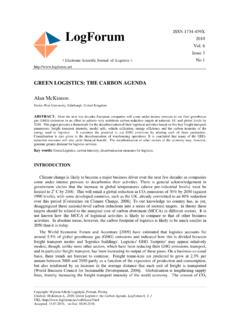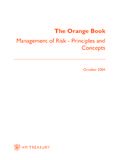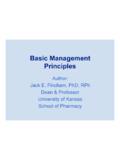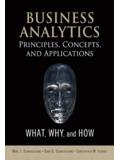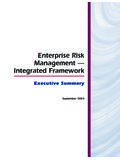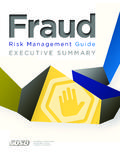Transcription of LEAN AND AGILE SUPPLY CHAIN MANAGEMENT …
1 ISSN 1734-459X. LogForum 2010. Vol. 6. Issue 4. > Electronic Scientific Journal of Logistics < No 3. LEAN AND AGILE SUPPLY CHAIN MANAGEMENT CONCEPTS IN. THE ASPECT OF RISK MANAGEMENT . Sylwia Konecka Poznan School of Logistics, Poznan, Poland ABSTRACT. Lean and AGILE SUPPLY CHAIN managements, as well as the hybrid forms (leagile SUPPLY chains), are popular and relatively widely discussed in literature. However, there are some disputes concerning differentiating these types of the MANAGEMENT from tools and instruments such as outsourcing, single sourcing, quick response, standardizing principles and postponement. The above-mentioned concepts are discussed in a positive light as tools for achieving a competitive advantage of SUPPLY chains. A recently introduced term SCRM ( SUPPLY CHAIN Risk MANAGEMENT ) emphasizes the importance of the risk MANAGEMENT in SUPPLY chains also due to the ability to achieve a competitive advantage of those chains in which a risk is identified, estimated, managed and controlled.
2 Therefore, it seems to be of benefit to look for the relationships and dependencies between these concepts (some references were made to the author's own research). A significant part of the papers concerns the identification of risks related to the above-mentioned instruments of SUPPLY CHAIN MANAGEMENT . However, the concepts of lean and AGILE MANAGEMENT are often discussed due to the fundamental determiners of the functioning of a SUPPLY CHAIN such as the nature of the demand, the character of goods and the total lead-time. According to the author, the discussed concepts could be viewed concerning SUPPLY CHAIN risk MANAGEMENT . It could facilitate the choice of a SUPPLY CHAIN strategy based on the risk analysis. Several case studies were included to support the presented considerations.
3 Key words: risk, SUPPLY CHAIN risk MANAGEMENT , lean SUPPLY CHAIN , AGILE SUPPLY CHAIN . The basic criteria for the evaluation of SUPPLY chains are leanness, ability to react and flexibility [Ciesielski 2001, Pfhol 1999]. The emergence of "lean" SUPPLY chains is a result of the use of relationships between the quality and costs - two factors that affect the competiveness. The other ones are: time, price, speed, customer satisfaction, productivity, diversity and technology. The quick response ability refers to the reaction to changes of the demand and depends on the level of the cooperation and the integration within the SUPPLY CHAIN . However, the flexibility allows adapting the logistic system of the company to mutable environmental conditions by using the time factor. Another factor should be also taken into account in today's analysis of the SUPPLY CHAIN - the risk.
4 Emphasizing the importance of the risk, the terms "vulnerable" or "resilient" SUPPLY chains or SCRM ( SUPPLY CHAIN Risk MANAGEMENT ) are begun to be used. It should be pointed that, in addition to the vulnerability, the SUPPLY CHAIN needs proper selection of five "V" elements such as: value, velocity, variability and visibility [Closs 2004]. The three most important determinants of the functioning and the development of global (as the most popular) SUPPLY chains are: the product's characteristics, the nature of the demand and the total replenishment time [Christopher, Towill 2002]. The identification of factors influencing the SUPPLY CHAIN and its attributes leads to the designation of main decisions in SUPPLY chains, which should help to increase the competiveness, as well as to have its reference to the risk, which always existed but only recently has gained the high importance, especially for SUPPLY chains [Ritchie, Brindley 2005].
5 The conclusion can be formed from the analysis of the literature and research Copyright: Wy sza Szko a Logistyki, Pozna , Polska Citation: Konecka S., 2010, Lean and AGILE SUPPLY CHAIN MANAGEMENT concept in the aspect of risk MANAGEMENT . LogForum 6, 4, 3. URL: Accepted: , on-line: Konecka S., 2010, Lean and AGILE SUPPLY CHAIN MANAGEMENT concept in the aspect of risk MANAGEMENT . LogForum 6, 4, 3. URL: reports that SCRM is the essential element of business, particularly in the SUPPLY CHAIN and hence the attempt was made to analyze the concept of the SUPPLY CHAIN MANAGEMENT , also because of the risk, they are related. The own researches were conducted in reference to the results of Aberdeen Group, which among other, were related to the perception of the relationship between tools for the SUPPLY CHAIN MANAGEMENT and the increase of the risk level.
6 Such instruments were mentioned as: centralized distribution, reduction of suppliers' base, centralized production, reduction of stock level, outsourcing, single sourcing, JIT (Just In Time), VMI (Vendor Managed Inventory), LCCS (Low Cost Countries Sourcing). The respondents were asked to decide if there are relationships between above-mentioned factors and the risk level or not or if they do not have an opinion on that subject. Table 1. Dependencies between selected instruments for SUPPLY CHAIN MANAGEMENT and the risk level Tabela 1. Zale no ci mi dzy wybranymi instrumentami zarz dzania a cuchem dostaw a poziomem ryzyka percent of response [%]: There is a There is no dependency I have no opinion . instrument of SUPPLY CHAIN MANAGEMENT dependency . centralized distribution 61 19 20. reduction of suppliers' base 73 6 21.
7 Centralized production 45 27 28. reduction of stock levels 73 8 19. outsourcing 66 19 15. single sourcing 64 9 27. JIT 69 6 25. VMI 54 10 36. LCCS 54 8 38. Source: own work The majority of respondents confirm the presence of the indicated dependency, so it seems to be relevant to make the risk analyze of the concepts: lean, AGILE , leagile and tools of SUPPLY CHAIN MANAGEMENT connected with them. However those relationships are quite complex, the risk can increase in case of using one tool and decrease for the other one. Therefore, the situation can be quite complicated when a few tools are used simultaneously. Therefore, the first task should be to systematize the knowledge of concepts, strategies and tools of SUPPLY chains and only then to attempt to conduct the risk analysis. SUPPLY chains and SUPPLY CHAIN MANAGEMENT change and evolve mainly under the pressure of the competition.
8 Generally, the existing activities of SUPPLY CHAIN MANAGEMENT aim at the cost reduction by using instruments for their leanness (lean MANAGEMENT concept) or at higher service level by higher flexibility ( AGILE MANAGEMENT concept). The realization of the operation better than competitors may be performed by providing the same or comparable products but at a lower price. It is so called the cost leadership. The lean MANAGEMENT shows the methods to reduce the costs and to sell cheaper than the competitors do. The application of the lean concept enables to reduce the logistic costs, generally by eliminating any loss in the SUPPLY CHAIN (so called muda). It could be: the designing of efficient operations, the reduction of stocks levels, the flow time's reduction, lower use of resources, lower employment, and elimination of doubled without added value actions.
9 The achievement of these objectives is possible by the use of such methods as: JIT, continuous improvement, time compression, no-stock production, TQM. Lean SUPPLY chains allow obtaining the advantage on markets, where the demand is relatively easy to predict and plans and schedules, prepared on basis of demands forecasts, are precisely realized. The benefits of the implementation of the lean MANAGEMENT are obvious, but it can be also concluded, that 24. Konecka S., 2010, Lean and AGILE SUPPLY CHAIN MANAGEMENT concept in the aspect of risk MANAGEMENT . LogForum 6, 4, 3. URL: the more efficient operations are connected with the higher risk, because of higher attention to costs matters and therefore the difficulties in coping with unforeseen events [Waters 2002a]. The AGILE MANAGEMENT is an alternative approach.
10 AGILE MANAGEMENT consists in carrying out the activities connected to strategy of the diversification, to deliver the product, the consumers cannot find elsewhere. The quick response to changes in the demand is most important. This activity in logistic operations involves the use of flexible and AGILE operations to provide an excellent service level of final customer [Waters 2002b]. It could be measured as: the ratio of products delivered to ordered, the quantity of mistakes made during the sorting process, the ability to "cancel" the orders, the percentage of orders fulfilled in 100% in accordance with requirements, the size of damage, price reduction due to failure to meet delivery times, easiness to prepare the goods in accordance with order, etc. This strategy allows reacting to unforeseen events such as short delivery delays, changes in demands as well as natural disasters.


